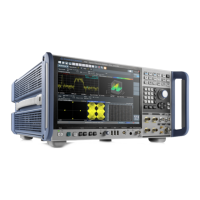Network and Remote Operation
R&S
®
FSW
766User Manual 1173.9411.02 ─ 43
3. CALL InstrWrite(analyzer, "*INIT;*OPC") ' Generate an SRQ after
operation complete
After its settings have been completed, the instrument generates an SRQ.
A detailed example for a service request routine is provided in Chapter 14.15.2, "Ser-
vice Request", on page 1378.
Serial Poll
In a serial poll, just as with command *STB, the status byte of an instrument is queried.
However, the query is realized via interface messages and is thus clearly faster.
The serial poll method is defined in IEEE 488.1 and used to be the only standard pos-
sibility for different instruments to poll the status byte. The method also works for
instruments which do not adhere to SCPI or IEEE 488.2.
The serial poll is mainly used to obtain a fast overview of the state of several instru-
ments connected to the controller.
Parallel Poll
In a parallel poll, up to eight instruments are simultaneously requested by the controller
using a single command to transmit 1 bit of information each on the data lines, i.e., to
set the data line allocated to each instrument to a logical "0" or "1".
In addition to the SRE register, which determines the conditions under which an SRQ
is generated, there is a Parallel Poll Enable register (PPE) which is ANDed with the
STB bit by bit, considering bit 6 as well. This register is ANDed with the STB bit by bit,
considering bit 6 as well. The results are ORed, the result is possibly inverted and then
sent as a response to the parallel poll of the controller. The result can also be queried
without parallel poll using the command *IST?.
The instrument first has to be set for the parallel poll using the command PPC. This
command allocates a data line to the instrument and determines whether the response
is to be inverted. The parallel poll itself is executed using PPE.
The parallel poll method is mainly used to find out quickly which one of the instruments
connected to the controller has sent a service request. To this effect, SRE and PPE
must be set to the same value.
Query of an instrument status
Each part of any status register can be read using queries. There are two types of
commands:
●
The common commands *ESR?, *IDN?, *IST?, *STB? query the higher-level
registers.
●
The commands of the STATus system query the SCPI registers
(STATus:QUEStionable...)
The returned value is always a decimal number that represents the bit pattern of the
queried register. This number is evaluated by the controller program.
Remote Control Basics

